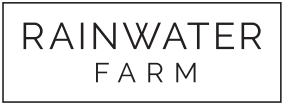Rainwater Farm Reaching Out - Soap Beyond Borders
Detoxing Your Carryon and Living the Dream

Picture this: you’re packing your suitcase to go on a fabulous Mediterranean cruise. Little birds flutter in your window and help you fold your floaty beach cover-ups, your stylish-yet-comfy sandals, and your one dress that’s somehow appropriate for all occasions and yet never gets wrinkled. You toss in a couple classic novels you’ve always meant to read and a cashmere throw that will snuggle you to a peaceful sleep on the plane. You find your cute cosmetics bag without having to dig through your entire closet, and it’s full of beautiful, natural products that will moisturize your skin, soothe your spirit, and protect against germs during your journey. You lay everything out neatly on your bed and take a picture—finally, you’ll be one of those people on Instagram who jet-set around the globe without breaking a sweat! This trip is just a kickoff to your new career as a life coach and organization specialist! (And maybe magician, because how did those birds learn to fold clothes?!) Everything is finally coming together!
...And then you wake up and realize you have two hours to pack and be at the airport and who even knows where your suitcase is and whether the clothes you need are clean. Ah, yes, this is real life! Where your nicely-folded shirts have a party in your suitcase and end up at your destination more wrinkled than you thought possible. Where your cosmetics bag is full of lipsticks that always get on everything, samples of lotion from the last hotel you stayed at, and harsh-smelling hand sanitizer that you’ve heard might be bad for you, but there’s no way you’re braving an airplane bathroom without it.
Alas, we can’t help you with the wrinkled clothes (seriously—we’ve tried rolling, packing in plastic bags, sweet-talking, cursing...please send help), or get you to your flight on time. However, we do have a few suggestions for at least partly fulfilling the fantasy above by improving the state of your carry-on cosmetics—in ways that might just preserve your sanity on those holiday trips to visit the in-laws.

Protect with It Takes a Thief Soap and Spray
Hand sanitizers like Purel are used in hospitals for a reason. But for everyday use, they’re like trying to mow your lawn with a grenade—yes, they’ll destroy harmful bacteria, but they’ll also obliterate helpful bacteria and dry out your skin while making your hands smell like a doctor’s office. Our It Takes a Thief products are perfectly balanced in their germ-fighting ability, and—of course—all-natural. In fact, the blend of essential oils we use harkens back to the medieval ages, when a band of thieves used a similar blend to protect themselves from plague victims. Use the It Takes a Thief spray to cover your body, clothes, and linens with a protective mist, and It Take a Thief bar soap to wash away the day. If you’d like to learn more about our natural, antibacterial and antimicrobial bodywash, soaps, and sprays, check out this post!
Soothe with Healing Salve
We’re all familiar with Sad Purse Lotion—the small, stolen-from-the-hotel bottle with mystery ingredients, weird-smelling, covered in scratches, and waiting to explode at any moment. These are the lotions that most often go in our carryons, but they’re more harmful than they look. Wonder why these lotions smell like (fake) lemon verbena or gardenia for years? It’s because of the added parabens, which preserve the oils, but can be a harmful skin irritant. Our travel-sized Healing Salve is small enough to toss in your purse yet potent enough to soothe and heal dry skin and scrapes, naturally. And smooth skin is healthy, protected skin. (Bonus: it’s in a tightly-sealed jar, to lessen the chances of your whole purse getting Healing Salved.)
Replenish with Citrus Lip Balm
It’s a well-known fact that airplanes are designed to enact as much misery as possible on your body, not least of which is to slowly leach out all moisture from your pores while making you terrified to drink lest you need to use the tiny restroom during turbulence. While we can’t change the plane’s air quality, we can help soothe your chapped lips after your post-red-wine nap (no judgements here!). Our Citrus lip balm soothes and moisturizes your lips with a blend of almond oil, beeswax, Vitamin E oil, and essential herbal oils—a bit more appealing than your Chapstick or Carmex, which has a petroleum base derived from the same engine oil that’s powering your plane! And it’s energizing—a spot of soothing sunshine during your journey.
Sleep Tight with Lavender Mist
Speaking of dry lips, here’s a supermodel travel secret: use an essential-oil infused mist to hydrate your face. The gentle, pure lavender oil in our Lavender Clean Mist is not just soothing—it makes your complexion dewy and fresh (and it’s a great under-makeup treatment, if you decide to freshen up in the airport lounge).
And it does double-duty: stale bus air, musty hotels, childhood bedrooms that still smell like the clouds of Clinique Happy we used in high school (sorry mom)...traveling is full of fun aromas! Sometimes you just want it to smell like home, and you want to sleep as well in your hotel bed as you do in your own bedroom. Use Lavender Clean Mist as a pillow spray to relax before bed, and as a Febreze stand-in to refresh your travel clothes!

Don’t they look pretty all laid out together? Maybe you could be that Instagram-star-life-coach after all...and still make your flight on time!
Now through Saturday, October 31 all items in our Travel Essentials collection are 20% off! Enter DETOX at checkout.
Rainwater in the Kitchen: Lavender Tenderloin
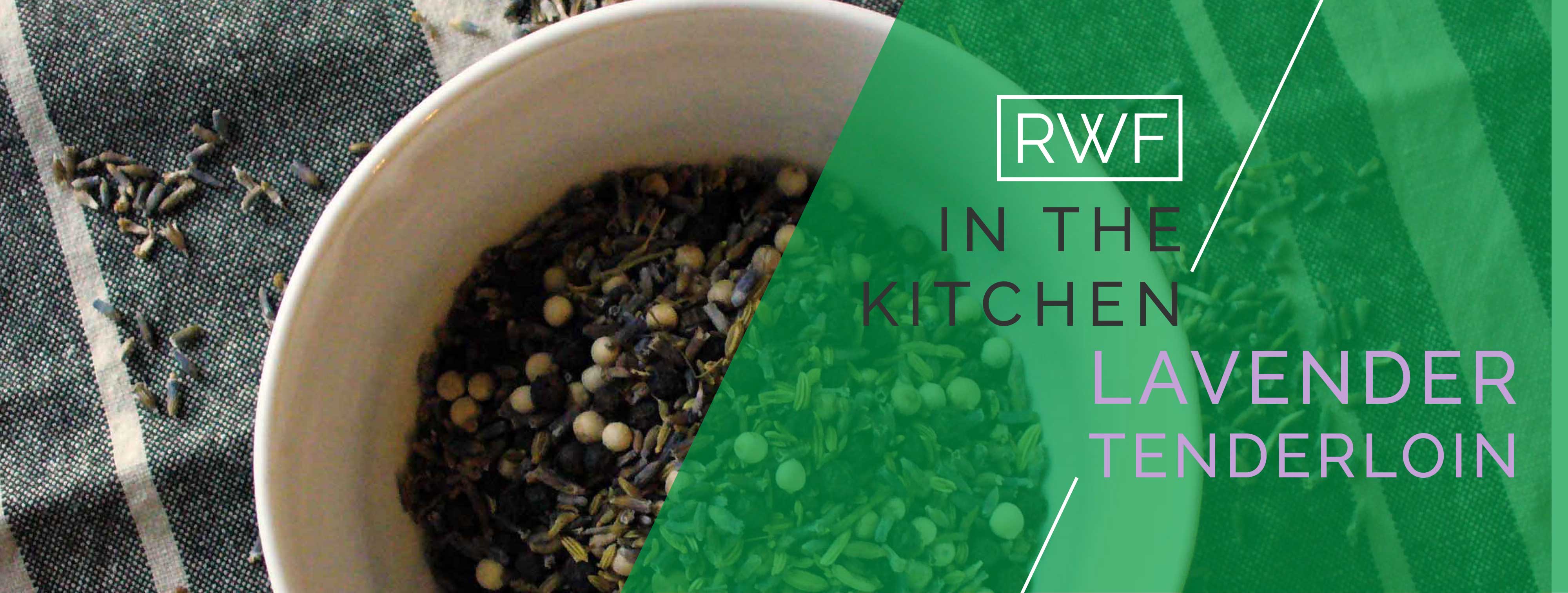
We’ve said it before: our ingredients are so natural, you could eat our soap if you wanted to — but that probably doesn’t sound too appetizing (Ralphie from A Christmas Story would agree). A better idea? Let’s explore some of our ingredients that can be just as delicious as they are healthy for your skin. In our first dish of this series, we're cooking Ellen Sullivan's Lavender Tenderloin, from One Big Table by Molly O'Neill.
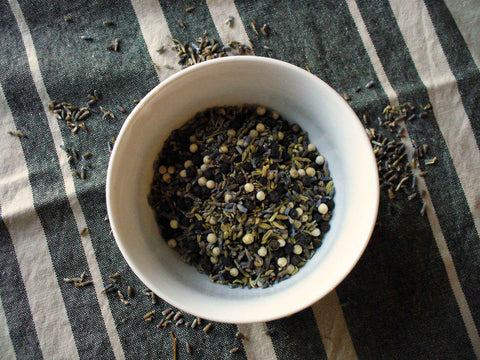
First up: lavender. We use this plant as an essential oil in many of our favorite products, like our classic Oatmeal Lavender bar soap or our Lavender Clean Mist, and we love its soothing, stress-relieving properties (learn more here). In the kitchen, you can use culinary-grade lavender to impart an herbal, floral note to meats, baked goods, and drinks. For our first foray into food blogging, we’re starting off with a bang—a show-stopping preparation for beef tenderloin that’s easy to serve to a crowd and feels elegant enough for a celebration (we’ve bookmarked this for our 25th anniversary party!).

Lavender is used here in the spice rub—it’s ground with peppercorns and fennel to give the meat a spicy, herbal crust as it tenderizes overnight in the fridge. (Picture a tenderloin relaxing with our Lavender Bath Balm after a long day at work.) About an hour before your guests arrive, you’ll take the meat out, pop it in the oven for a few minutes, and serve while looking like the effortless host that you are. It’s really that easy! And, if you’re not in the mood to serve a crowd, you can easily scale down the size of the tenderloin (or use another favorite cut of meat) and save the leftover spice rub for another day.

If you're in the Nashville area and looking for a locally-sourced tenderloin, we recommend our friends at Porter Road Butcher. Their beef is pasture-raised, free of antibiotics and hormones, and an important source of tallow for our soaps—so you'll be supporting a true circle of sustainability, Lion King-style! Learn more about our collaboration with Porter Road Butcher here.
We hope you enjoy experimenting with this powerful botanical - and if you try this recipe, let us know in the comments! Cheers!
_______________________________________________________________________________
Ellen Sullivan's Lavender Tenderloin
From One Big Table by Molly O'Neill:
In 1998, Ellen Sullivan purchased land in Northern San Diego County, California, named it The Lavender Fields, and planted, grew, and harvested fields of lavender. She also searched for culinary uses for the plant, which is still considered more of an aromatic flower than a herb. "The first modern culinary use I saw was a chef's recipe for lavender crème brûlée, and that got me thinking. Lavender's flavor is both tangy and floral, so it works as well in savory dishes as it does in sweet ones—I love what it does to beef tenderloin." This recipe remains one of Ms. Sullivan's favorite company meals.
Ingredients
- 2 tablespoons dried food-quality lavender buds
- 2 tablespoons fennel seeds
- 1 tablespoon whole black peppercorns
- 1 tablespoon whole white peppercorns
- 1 1/2 teaspoon dried thyme
- One 4 1/2-pound whole beef tenderloin, trimmed and silverskin removed
- 2 tablespoons olive oil
Preparation
- The day before serving, grind the lavender, fennel, peppercorns, thyme, and salt to a powder with a mortar and pestle or in a spice grinder. Rub the tenderloin with the spice mixture, wrap tightly in plastic wrap, and refrigerate for 8 to 24 hours.
- Remove the tenderloin from the refrigerator and let sit at room temperature for 30 minutes. Place an oven rack in the center position and preheat the oven to 425°F. Place a rack inside a roasting pan.
- Remove the plastic wrap, brush off the spices from the tenderloin, and rub with 1 tablespoon of the oil. Place the tenderloin on the rack and roast for 15 minutes, turning once halfway through.
- Reduce the heat to 325°F and roast for 5 to 15 minutes longer, to the desired doneness (an instant-read thermometer will read 125°F for medium rare). Rainwater Note: cooking time may vary depending on the thickness of the cut and your oven temperature; our tenderloin took about 25 minutes to reach 125°.
- Transfer the roast to a carving board and let rest, loosely covered with foil, for 10 minutes. Meanwhile, add the remaining olive oil to the roasting pan, scrape well, and stir to combine the drippings.
- Cut the tenderloin against the grain into 1/2-inch-thick slices and transfer to a serving platter. Drizzle the pan drippings over the meat and serve.
________________________________________________________________________________
From One Big Table: A Portrait of American Cooking by Molly O'Neill. Copyright © 2010 by Molly O'Neill. Published by Simon & Schuster.

Laundry Room Detox

Over the past few years we’ve had so many conversations with friends and customers about the (exciting and glamorous!) topic of… laundry detergent. We meet people all the time who suffer from chronic dry skin and itchiness. Sometimes they (or their child) might be constantly fighting more aggressive skin dermatitis such as psoriasis and eczema. And in some cases, we’ve encountered parents whose children struggle with asthma and respiratory issues and are trying to pinpoint any household environmental factors that could be exacerbating it. One of our first suggestions is always to change the way they clean their laundry, and unsurprisingly, these same customers eventually call, email, or come back to share with us how big of a difference it made for them.
As we all become more thoughtful with the types of cleaning products, soaps and skincare products we use, eliminating or replacing the items in our showers, medicine cabinets, and makeup drawers--the laundry room goes largely unnoticed and untouched. This is understandable! It’s not easy to even find the ingredients in a box or jug of laundry detergent or fabric softener--much less figure out more natural substitutes or even where to buy those.
So, today we’re going to break down the entire topic of laundry detergent and how (and why!) you should think about a full-scale Laundry Room Detox! We’ll talk about some of the most common ingredients in laundry detergent and fabric softeners, and also share some tips and tricks. Ultimately, we love sharing information that has helped so many people already, and can help you and your family find relief from skin and respiratory issues while reducing your daily exposure to chemicals and compounds that, over time, can be harmful for your bodies and skin.
Why Should I Consider A Laundry Room Detox?
Consider overhauling all of your laundry products and switching to natural soaps and solutions if you:
- struggle with consistent skin irritation or chronically dry skin- have a family member or child who suffers from eczema or psoriasis
- have a family member or child who struggles with asthma or other respiratory issues (and take a look at this study from the University of Washington, which measured dryer vent emissions and identified toxic and carcinogenic VOCs caused by the ingredients in detergents and fabric softeners)
- launder cloth diapers or clothes for newborns and babies
- find that your clothes often feel stiff, or tend to emit trapped odors (have you ever washed workout clothes just to find that they start smelling bad once you put them on again?)
- have concerns about the environmental impact typical laundry chemicals and detergents have on the environment, particularly the aquatic ecosystem
What ingredients are in laundry detergents and fabric softeners?
1,4 Dioxane: This isn’t an ingredient actually, it’s a byproduct of a process used in the creation of sodium lauryl sulfate (or, SLS). At worst--it’s a very probable carcinogen and can cause damage to the central nervous system and internal organs. At best, it is irritating to the eyes, respiratory tract, and skin, as outlined by this CDC fact sheet. Bottom line, 1,4 Dioxane poses too large of a risk for anyone to want it in contact with their skin day in and day out.
Phosphates: Phosphates are compounds that help the cleaning components of the detergent to act, in effect, softening the water and preventing the mineral ions in water from blocking the cleaning action. This all sounds great, right? Well, unfortunately, water treatment processes do not remove these phosphates from the water supply--and a large amount of these compounds are released into streams, lakes and rivers. Once they are in the water system, these compounds greatly accelerate the natural growth of organic material in the water system which in turn strips oxygen from lakes and rivers, making the water uninhabitable for fish and other aquatic life. Long story short, phosphates in detergents are doing a number on our natural environment, and while the EU has already taken strong steps to eliminate phosphates from laundry products, the US is far behind. (This paper from the University of Colorado is a great resource for anyone wishing to take a deeper look)
Nonylphenol Ethoxylate (or NPEs): NPEs are found mostly in industrial cleaners and is yet another petrochemical. Similar to parabens and BPA, they mimic the hormone estrogen and are endocrine disruptors, which as defined by the National Institute of Environmental Health Sciences, are “chemicals that may interfere with the body’s endocrine system and produce adverse developmental, reproductive, neurological and immune effects in both humans and wildlife.” NPEs do not easily or quickly biodegrade, and according to the EPA, they are "extremely toxic" to aquatic organisms.
Dyes and Fragrances: We all want our laundry to smell fresh and lovely, but at what cost? Surprisingly, there is no real regulation of the word “fragrance,” meaning the chemical cocktail of compounds used to achieve the smell of Fresh Rain or Clean Cotton do not have to be disclosed by manufacturers. (And, even more troublesome: many "Fragrance Free" detergents aren't really fragrance free, they just have added additional chemicals to mask any smell). One of the troublesome substances in fragrances (from cosmetics and soaps to laundry detergents and dryer sheets) are pthalates, which are probably carcinogens and endocrine disrupters. At the very least, we’ve found that these fragrances can be highly irritating: causing itchy, irritated skin and exacerbating any existing dermatitis. Take a look at Nicholas Kristof’s article in the New York Times about pthalates and other endocrine disrupters if you’re interested in learning more!
Optical Brighteners: If you’ve seen the detergent commercials that claim “Whites look whiter, and brights look brighter,” then you are probably already familiar with optical brighteners. These brighteners can be synthesized using a wide variety of chemicals and they can vary from product to product, but if you’d like to read up on some of the most common ones, this article has a good rundown.
How can I detox my laundry room? What are good, non-toxic substitutes for laundry detergents, fabric softeners, and dryer sheets?
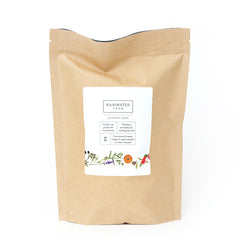
Rainwater Farm Natural & Fragrance-Free Laundry Soap
One thing we do NOT want is for a laundry room detox to feel overwhelming, so we’re sharing some simple tricks and steps that will help you have fresh laundry, cleaner air, and healthier skin.
Use a laundry soap, not a laundry detergent: Here at Rainwater Farm we do make a fragrance-free, natural, and non-toxic laundry soap. It is highly concentrated and compatible with both standard and HE machines. You can buy it here, or, if you’re up for trying to make your own detergent there are many recipes out there for you to follow. Just make sure you’re grating or grinding a natural, pure soap, castile or otherwise: not a standard bar of grocery store soap. We sell bars of gentle and unscented soap here as well (which also, I might add, makes for an amazing stain remover or pre-treater!).
Use essential oils for lovely-smelling laundry: I personally don’t need my laundry to smell like anything but clean. But, for those who might want a little extra fragrances, use a few drops of your favorite essential oil during the rinse cycle!
Use Borax or washing soda: When you do use your natural laundry soap, be sure to add Borax or Washing Soda. Both are available for a few dollars at your local grocery store, and are a gentler, environmentally-friendly way to soften and condition your water to allow dirt to be pulled out of your clothes and be washed away. Use even if you have a water softener or naturally soft water--and definitely use if you have hard water!
Use warm or hot water: Whenever possible, use warm or hot water with your laundry soap, to enhance the soap’s effectiveness.
Use wool dryer balls: We actually think you’ll notice a difference in the stiffness of your laundry just by using a natural laundry soap a few times. But, if you’d like to replace your fabric softener, use these felt or wool dryer balls in your dryer, especially for baby clothes or cloth diapers!
Questions, comments, or tips of your own? Did we miss anything? Have you noticed a difference since switching to natural laundry products? We'd love to hear in the comments!
Top Three Reasons to Incorporate Lavender Into Your Skincare Routine

It’s a running joke between mom and I that she is on “lavender autopilot,” adding lavender essential oil to all of the products we make. To be fair, when an essential oil smells as good as lavender does and has such amazing properties to boot, it’s hard to think of a reason not to use it daily. So, carry on, Colette!
And for the rest of you, continue reading below to learn the top three reasons we believe you should incorporate lavender into your skincare routine.
Note: Of course, the below applies only to true, natural lavender. If your skincare product ingredient listing says “fragrance,” then unfortunately, the benefits listed below don’t apply. For example, many mamas use Johnson & Johnson Lavender lotions or bath products on their babies around bedtime, but unfortunately it doesn’t contain any true lavender--just artificial lavender fragrance.
Reason #1: Lavender soothes skin irritations and inflammation: Is your skin chronically dry or itchy? Do you have eczema, psoriasis, dermatitis (inflammation of the skin), or dandruff? Bug bites or minor burns? If so, then lavender is an amazing natural remedy. It is soothing, it reduces redness and swelling--and it stimulates cell growth and renewal which promotes healing. Pregnant or new mothers might like to take note of this study, which demonstrates the efficacy of lavender in reducing post-partum redness and swelling.
Reason #2: Lavender is a natural antiseptic: A few years ago, a study conducted by researchers at the University of Coimbra in Portugal showed that Lavender oil proved lethal to a range of pathogenic fungi and various species of Candida. In addition, there have been a few studies demonstrating that lavender oil proved effective in treating drug-resistant MSSA and MRSA. And those who battle skin blemishes or acne might be interested to know that lavender helps fight acne-causing bacteria.
So, think of lavender as a natural Neosporin, and apply diluted lavender essential oil or a salve to cuts and scrapes to help clean and disinfect.
Reason #3: Lavender Relieves Stress & Anxiety: There are countless studies that demonstrate lavender’s ability to promote relaxation and reduce anxiety--and I’m sure many of you already love using lavender mists, diffusers, bath salts, or bodywashes in your evening routines to reduce insomnia and even quiet fussy children. So, suffice it to say: if you’re nervous while waiting for the dentist, scared of shots, or just want to sleep more soundly, lavender is your BFF!
And now that we have all that science out of the way, it’s Rainwater Shameless Plug Time! We’ve rounded up all of our lavender products onto one single page, and they are all ready and waiting for new homes (yours). Some of our favorites are as follows:
Lavender Clean Mist: Spritz on your face and neck during the summer for instant cooling, or spray on pillows and linens before bedtime.
Lavender Bodywash: This will very likely be the gentlest, most soothing bodywash you’ve ever tried. Our pure, vegetable-based formula is mild enough for use with babies, and will leave your skin soft and silky--not tight and dry like most bodywashes.
Oatmeal Lavender Bar Soap: We love recommending this soap for people who suffer from eczema and psoriasis. The soothing properties of lavender are further enhanced by our addition of gluten-free oatmeal. It’s also a good soap for kiddos or adults with shingles or chicken pox.
Simply Lavender Soap: This is my go-to gift for new mothers. The soap is gentle and nourishing, and perfect for nighttime bath routines.
Lavender Bath Balm: There’s nothing more relaxing than a bath with our Lavender Bath Balm, and it’s Part II of my New Mother Gift Pack, helping reduce post-partum swelling (see above!).
Nerdfest Alert: References & Further Reading
Lavender - University of Maryland Medical Center
What are the health benefits of Lavender?
Vakilian K, Atarha M, Bekhradi R et al 2011 Healing advantages of lavender essential oil during episiotomy recovery: a clinical trial. Complementary Therapies in Clinical Practice 17:50-53
Lehrner J, Marwinski G, Leh S, et al 2005 Ambient odors of orange and lavender reduce anxiety and improve mood in dental office. Physiology & Bahavior 86: 92-95
Sibel R et al 2009 The antimicrobial activity of high-necrodane and other lavender oils on methicillin-sensitive and -resistant staphylococcus aureus (MSSA and MRSA). The Journal of Alternative and Complementary Medicine 15(3): 275-279
Zu Y, Yu H, Liang L et al 2010 Activities of ten essential oils towards Propionibacterium acnes and PC-3, A-549 and MCF-7 cancer cells. Molecules 15:3200-3210
Safe & Non-Toxic Summer Essentials

This is the post where I spend a few paragraphs sufficiently freaking you out about summertime skincare products, to the point where you stay inside, safely air conditioned and away from bugs, sun, and fun...
Just kidding! While mom and I will generally never pass up an opportunity to get on our soapboxes (get it?!) about the slew of unpronounceable ingredients on commercial skincare labels that can spell t-r-o-u-b-l-e, we're also not out to frighten and overwhelm. Take the tips below as a way to feel empowered about the choices you make this summer, start by subbing in one natural product, and get outside and enjoy!
Bug Repellent: Should we be surprised at this point that nature has spent a few eons creating plant-based defenses against mosquitoes, gnats, and ticks? Instead of dousing yourself with DEET and other pesticides, use a natural bug repellent. Our natural Bug Repellent Spray, our Bug Repellent Stick, and our Camper Soap are formulated with essential oils of lemongrass, eucalyptus, rose geranium, cedarwood, and litsea cubeba--a great substitute for use especially by children and pregnant women. And yes. It does work: besides hearing our customers rave about the product year after year, dive-bombing mosquitoes and annoying gnats at a recent backyard BBQ here in Nashville were FOILED by our bug spray which left me more energy to drink sangria and kill it in bocce ball.
Sunscreen: The key to safe and natural sunscreens lie in physical sunblocks rather than chemical sunblocks. Women especially should avoid oxybenzone (an easily-absorbed endocrine disrupter) and look for non-nano zinc and other plant extracts that carry natural SPFs. You can use our Sun Stick Lip Balm for lip-specific protection, and while we don't currently carry a full-body sunblock (in development!) there are some great ones out there and you can use the Environmental Working Group's 2015 Guide to Sunscreens as a buying guide. And, if you're ocean-swimming this year, you'll be doing the coral reefs a big ole favor.
Poison Ivy Killer: Since I dropped out of Girl Scouts after the cookie-selling part of the gig, I'm still pretty terrible at identifying poision ivy (leaves of three? Almost all plants have three leaves...so confusing). So, our Summer Mint Soap is pretty much essential in the summer for me and all others who get poison ivy rashes just by looking in its general direction. This soap is tri-acting: because it's not a detergent, the soap molecules more effectively latch onto poison ivy oils and wash it away from your skin. The peppermint essential oils cool irritated skin, and the oatmeal gently soothes. And every summer we get orders from the patients of a few pediatricians in our area who recommend our Healing Salve for patients who got it, got it bad and want to go the non-steroid-shot-route.
Any tips and tricks of your own? Any natural summer skincare products you can't live without?
Sea Salt Acne Soap: Naturally Banish Blemishes
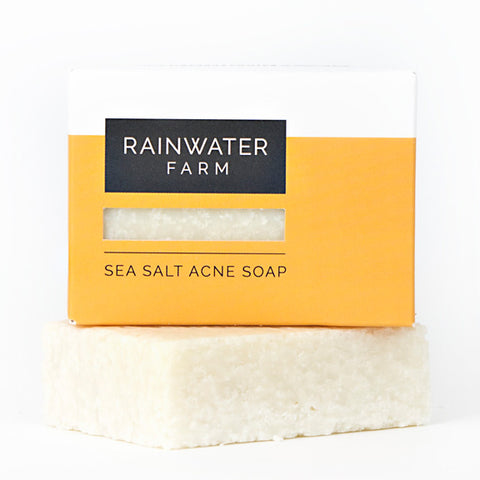
- True Soap (non-detergent): Most facial soaps and cleansers in the market are detergents, which are generally synthetically-derived cleansers that almost always have added foaming enhancers (sulfates) and chemical fragrances. These detergents can be quite harsh, irritating the face and skin, causing inflammation, and stripping the skin of its natural oils and defense barriers. By contrast, a true soap (comprised of natural oils or fats and mixed with an alkaline salt) are typically much gentler on the skin, the molecules of which are ionically charged to attract and attach to dirt or impurities so they can be washed away with water.
- Sea Salt: Naturally derived sea salt is rich in minerals and compounds that do wonders for your skin: extracting impurities, reducing redness and inflammation, and naturally and gently balancing the skin's pH to reduce the formation and growth of blemishes.
- Natural Toners and Hydrosols: It's super important to note here that we only recommend natural toners and hydrosols without any additions of alcohol or preservatives. A toner can be spritzed on the face just after cleansing and before moisturizing, and hydrosols can sprayed on the face before or after makeup application or really anytime during the day! These products will help further balance the skin's natural pH and while not crucial, can further balance and clarify your skin.
- Natural Moisturizers: While we can (and will, soon!) dedicate an entire post to natural body and facial moisturizers, we'll just leave this short and sweet: we're fans of natural oils and serums if you'd like to moisturize your face. You may be surprised that we recommend using oils when trying to prevent breakouts and acne--but the fact that oil does not cause blemishes is a myth we're happy to bust! We make an Illuminating Face Serum that does an amazing job in clarifying complexions and fading any acne scars or discoloration--but regardless of what you use, please make sure its free of petroleum by-products, parabens, and stay away from the word "fragrance" unless that smell is provided by an essential oil.
Here's to clear and happy skin--and if you have any questions, comments, or tips, please feel free to share them here!
One quick note about Sea Salt Acne Soap usage: if you experience tiny whiteheads after using the soap, in many instances this is a case of the skin purging impurities and toxins. Of course, everyone's skin is different so use your best judgement if this does not clear up within a few days of use.
